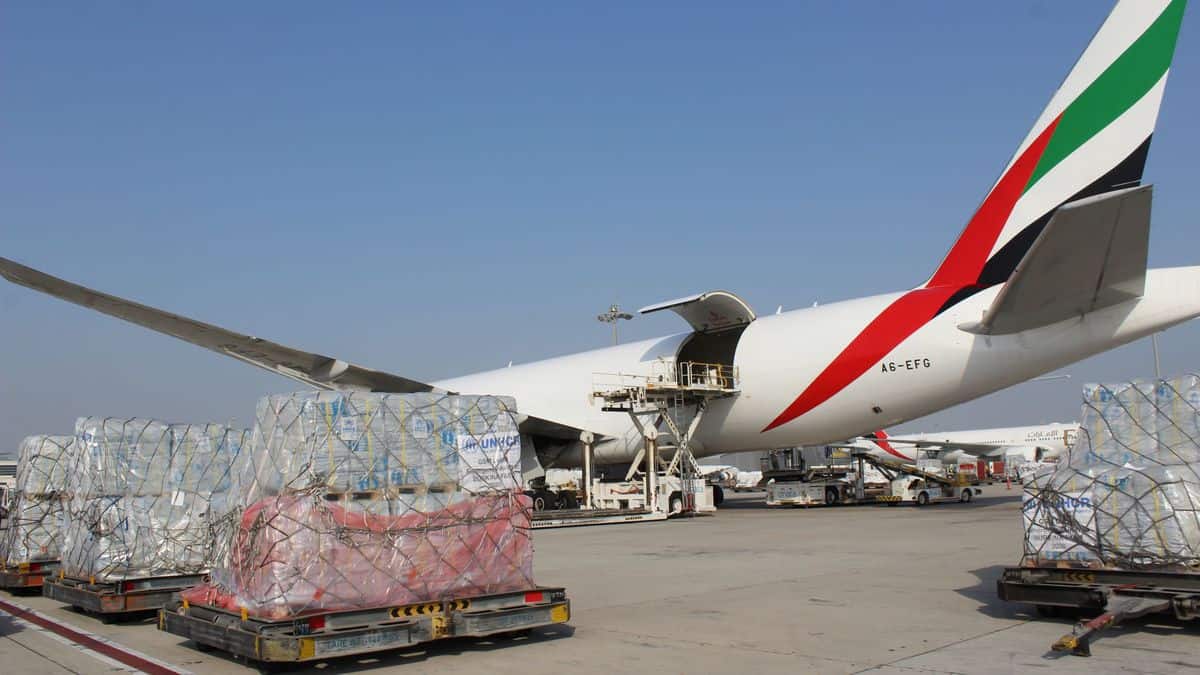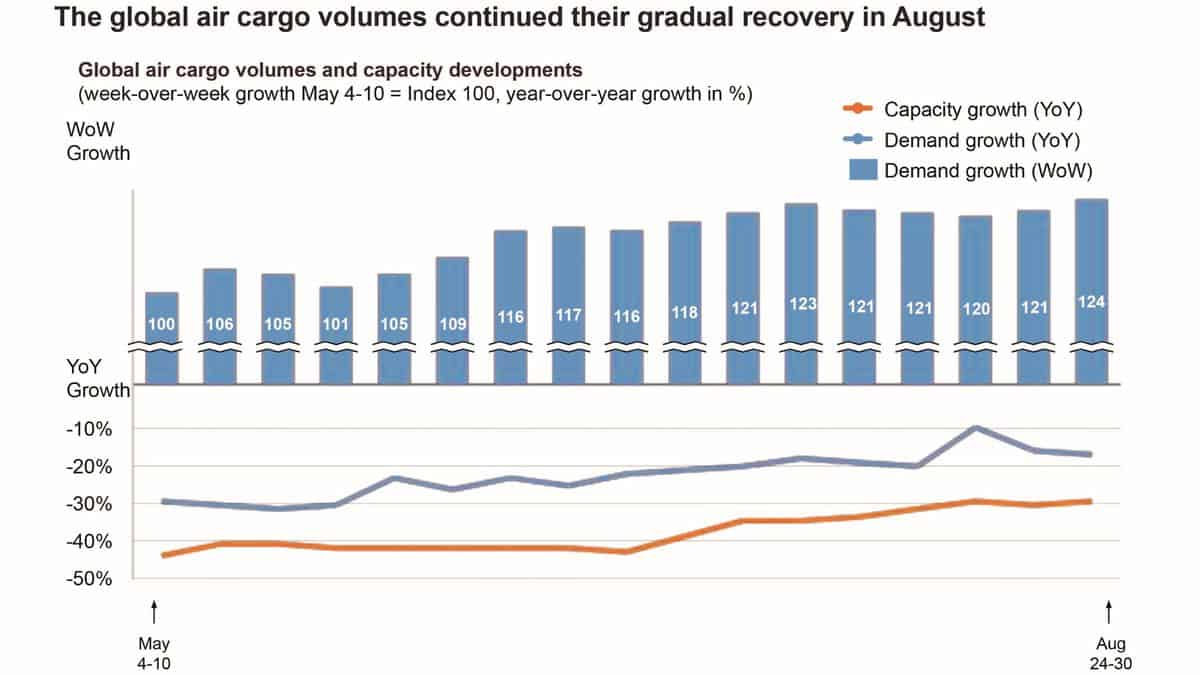After a three-week lull, prices for air exports from China have turned noticeably upward, a trend most international trade professionals expect will continue through the end of the year as the traditional peak shipping season overlaps with high demand for coronavirus medical supplies and online retail orders, and major product releases from big tech companies.
Outbound spot rates from China to Europe and the U.S. increased in the last week of August, highlighted by a 10.8% increase in the Shanghai-Europe market and an 18.4% rate hike for Shanghai to the U.S, according to data compiled by The Air Freight Index Co. (TAC)
With capacity leaving China about 19% less than last year, air cargo rates are about 25% to Europe and 35% higher on the transpacific.
Logistics providers say airfreight demand is even greater in other parts of Southeast Asia, with export rates $2/kilogram above that in China.
Trans-atlantic rates have softened, especially on eastbound flights.
Shippers should prepare to pay significantly more for airfreight in the coming months, especially on popular shipping routes from Asia, based on the latest data and forecasts.
“We see the reaction to supply and demand happening more swiftly,” said Robert Frei, The TAC Index’s business development director, in a statement. “This obviously has also to do with most carriers and forwarders breaking their contracts during the crisis and the fact that procurement is now done on a shorter-term basis.”
But San Francisco-based forwarder Flexport said in a client update that carriers, both all-cargo and passenger, are starting to move away from short-term transactions on lanes out of North America, such as the trans-Pacific westbound, where there is plenty of capacity. Many airlines are willing to give customers weekly and even monthly fixed rates instead of pricing each shipment on the spot based on supply and demand.
WebCargo, a digital air cargo marketplace with real-time rates and booking, set a monthly record for electronic bookings in August, according to parent company Freightos. It said a 13% increase in search volumes for air cargo rates during the last three weeks also suggest that bookings will continue to grow in the next few weeks.
And some players in futures markets are already offering as much as $7.50/kilogram from China to the U.S. in November to lock in the delivery price, up from about $5.40/kg today according to Freight Investor Services. Much of the capacity on freighters and passenger aircraft is already booked out, leaving few opportunities to book shipments in the fourth quarter, the London-based company said.
Many all-cargo aircraft and cargo-only passenger planes are committed to Apple, Samsung and Sony this fall for shipping new devices to customers, according to airline and logistics officials who decline to discuss specifics regarding publicity-averse technology companies.
A highly constrained ocean shipping market is also driving cargo owners to airfreight to get their goods to partners and customers. Carriers have raised rates six times since the end of May as demand continues to outstrip capacity, pushing the China-U.S. East Coast rates past $4,125 per standard container, according to Freightos. That is 50% higher than the same week in 2019. China-U.S. West Coast rates increased 3% early this week to $3,436/FEU – 113% higher than the same period a year ago.
Additional pressure on ocean shipping is due to equipment shortages and pre-ordering before the Golden Week national holiday in China when manufacturing shuts down for a week. The rush to beat Golden Week is also impacting airfreight, further contributing to rate increases, according to logistics providers.
Flexport said that other Asian countries are likely to adopt aggressive crew testing protocols used by authorities in Hong Kong as COVID infection rates rise, which could add to flight shortages. The intrusive nature of Hong Kong’s health screening and quarantine measures has led some airlines to scale back flights or make an extra stop to change crews in another country, adding time and cost.r
Airfreight backlogs are already starting to happen out of Shanghai and the situation is likely to deteriorate further as the month progresses, Wen-Parker Logistics said in its monthly market update for customers.
Capacity ticks up
Passenger capacity continues to incrementally come back, providing a small measure of relief for shippers facing a tight market for air transport.
United Airlines (NASDAQ: UAL) on Friday announced plans to fly 33% of its schedule next month compared to October 2019, up from 29% of its schedule in September. The increase is influenced by growth in leisure travel demand to Mexico, Central America and South America. Overall, United will operate at 40% capacity in October compared to 34% this month.
“We continue to be data-driven and realistic in our approach to rebuilding our network,” said Ankit Gupta, United’s vice president of domestic network planning, in a statement. “Because October is typically a slower month for leisure travel, we’re adjusting our schedules to reflect these seasonal changes in customer demand while resuming service or adding capacity on routes where we’re seeing increased customer demand for travel.”
Emirates is now operating to 81 points with the recent addition of several cities in Africa to its schedule and expressed optimism it will serve its entire entire network by next summer.
Qatar is resuming flights to Houston, Philadelphia and Mogadishu, Somalia, among others, this month. By mid-September it will operate more than 650 weekly flights to more than 85 destinations.
And Lufthansa Airlines relaunched service, five times per week, between Frankfurt and Washington Dulles International Airport using an Airbus A330-300.
Flexport said trans-atlantic westbound rates are likely to go up soon as passenger carriers decrease capacity during a period of strong demand.
Airfreight recuperates in August
Industry-wide, however, the capacity gains have kept air cargo rates in check this summer.
Load factors dropped from 70% in July to 68% in August, according to airline data compiled by Clive Data Services in London. Still, the market research firm noted, the amount of used space per aircraft was high considering August is typically a slow shipping month and was 8 points higher than a year ago.
Air cargo volume improved for the fourth consecutive month in August, despite a 17% drop in demand from the same month in 2019, Clive reported. You know you’re in a global pandemic when a 17% drop in demand from 2019 is considered good news. At the height of the coronavirus outbreak in April airfreight volume imploded 41% year-over-year. But rates out of China were five times greater than normal because a huge number of emergency orders for COVID protective gear coincided with the stoppage of most passenger flights.
Click here for more FreightWaves/American Shipper stories by Eric Kulisch.
RECOMMENDED READING:
Emirates brings back A380 super jumbo jet, more routes















Faster Freight
This is a great information, thanks for sharing.
Smart Contract MLM Script
Thanks for sharing!